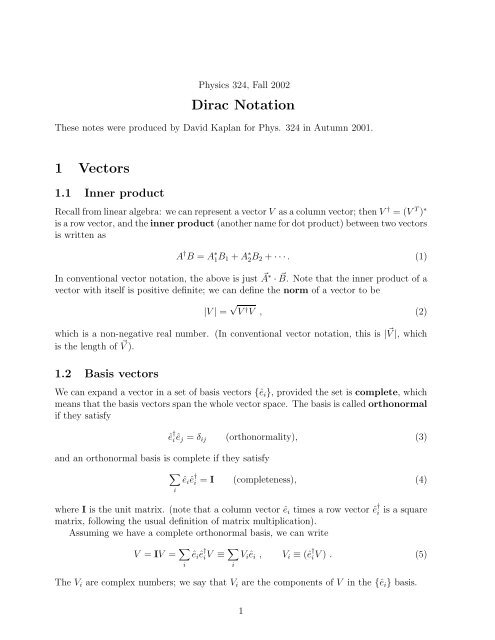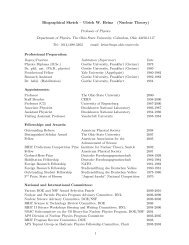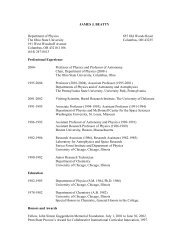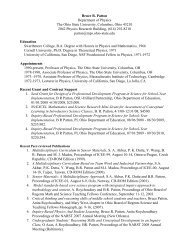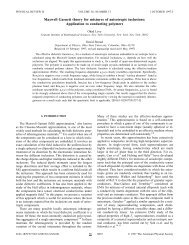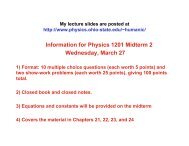Dirac Notation 1 Vectors
Dirac Notation 1 Vectors
Dirac Notation 1 Vectors
Create successful ePaper yourself
Turn your PDF publications into a flip-book with our unique Google optimized e-Paper software.
Physics 324, Fall 2002<br />
<strong>Dirac</strong> <strong>Notation</strong><br />
These notes were produced by David Kaplan for Phys. 324 in Autumn 2001.<br />
1 <strong>Vectors</strong><br />
1.1 Inner product<br />
Recall from linear algebra: we can represent a vector V as a column vector; then V † =(V T ) ∗<br />
is a row vector, and the inner product (another name for dot product) between two vectors<br />
is written as<br />
A † B = A ∗ 1 B 1 + A ∗ 2 B 2 + ···. (1)<br />
In conventional vector notation, the above is just ⃗ A ∗ · ⃗B. Note that the inner product of a<br />
vector with itself is positive definite; we can define the norm of a vector to be<br />
|V | = √ V † V , (2)<br />
which is a non-negative real number. (In conventional vector notation, this is | ⃗ V |, which<br />
is the length of ⃗ V ).<br />
1.2 Basis vectors<br />
We can expand a vector in a set of basis vectors {ê i }, provided the set is complete, which<br />
means that the basis vectors span the whole vector space. The basis is called orthonormal<br />
if they satisfy<br />
ê † iê j = δ ij (orthonormality), (3)<br />
and an orthonormal basis is complete if they satisfy<br />
∑<br />
ê i ê † i = I (completeness), (4)<br />
i<br />
where I is the unit matrix. (note that a column vector ê i times a row vector ê † i is a square<br />
matrix, following the usual definition of matrix multiplication).<br />
Assuming we have a complete orthonormal basis, we can write<br />
V = IV = ∑ i<br />
ê i ê † iV ≡ ∑ i<br />
V i ê i , V i ≡ (ê † iV ) . (5)<br />
The V i are complex numbers; we say that V i are the components of V in the {ê i } basis.<br />
1
1.3 Eigenvectors as basis vectors<br />
Sometimes it is convenient to choose as basis vectors the eigenvectors of a particular<br />
matrix. In quantum mechanics, measurable quantities correspond to hermitian operators;<br />
so here we will look at hermitian matrices. A hermitian matrix is one satisfying<br />
M = M † ≡ (M T ) ∗ (hermitian) . (6)<br />
This just means that the components of a hermitian matrix satisfy M ij = M ∗ ji.<br />
We say that the vector v n is an eigenvector of the matrix M if it satisfies<br />
Mv n = λ n v n , (7)<br />
where λ n is a number called an eigenvalue of M. If M is hermitian, the eigenvalues λ n<br />
are all real, and the eigenvectors may be taken to be orthonormal:<br />
v † m v n = δ nm . (8)<br />
So we can take the v n to be our basis vectors, and write an arbitrary vector A in this basis<br />
as<br />
A = ∑ n<br />
A n v n . (9)<br />
where the A n are in general complex numbers. This is a convenient choice if we wish to<br />
know what is the action of the hermitian matrix M when it multiplies the vector A:<br />
MA = ∑ n<br />
A n Mv n = ∑ n<br />
A n λ n v n . (10)<br />
2 <strong>Dirac</strong> notation for vectors<br />
Now let us introduce <strong>Dirac</strong> notation for vectors. We simply rewrite all the equations in the<br />
above section in terms of bras and kets. We replace<br />
V →|V 〉 , V † →〈V | , A † B →〈A|B〉 . (11)<br />
Suppose we have basis vector |i〉, analogous to the ê i , which form a complete orthonormal<br />
set:<br />
〈i|j〉 = δ ij (orthonormality)<br />
∑<br />
i |i〉〈i| = 1 (completeness) ,<br />
(12)<br />
where 1 is the identity operator; it has the property 1|ψ〉 = |ψ〉 for any |ψ〉.<br />
Then any vector |V 〉 may be expanded in this basis as<br />
|V 〉 = 1 |V 〉 = ∑ i<br />
|i〉〈i|V 〉≡ ∑ i<br />
V i |i〉 , V i ≡〈i|V 〉 . (13)<br />
2
Note that 〈V |i〉 = V ∗<br />
i .<br />
As before, we can use the eigenvectors of a hermitian operator for our basis vectors.<br />
Matrices become operators in this language, M → ˆM. Then the eigenvalue equation<br />
becomes<br />
ˆM|n〉 = λ n |n〉 , (14)<br />
where the λ n are real and we can take the |n〉 kets to be orthonormal: 〈m|n〉 = δ mn . Then<br />
we can write<br />
ˆM|V 〉 = ˆM ∑ V n |n〉 = ∑ ∑<br />
V n ˆM |n〉 = V n λ n |n〉 . (15)<br />
n<br />
n<br />
n<br />
3 <strong>Dirac</strong> notation for quantum mechanics<br />
Functions can be considered to be vectors in an infinite dimensional space, provided that<br />
they are normalizable. In quantum mechanics, wave functions can be thought of as vectors<br />
in this space. We will denote a quantum state as |ψ〉. This state is normalized if we make<br />
it have unit norm: 〈ψ|ψ〉 =1.<br />
Measurable quantities, such as position, momentum, energy, angular momentum, spin,<br />
etc are all associated with operators which can act on |ψ〉. IfÔ is an operator corresponding<br />
to some measurable quantity, its expectation value is given by 〈Ô〉 = 〈ψ|Ô|ψ〉. Note that<br />
since<br />
〈A|Ô|B〉∗ = 〈B|Ô† |A〉 ,<br />
(check this in the case of finite length vectors and matrices!) it follows that if your measurable<br />
quantity is real (and they always are!) then 〈Ô〉 = 〈Ô〉∗ implies that<br />
〈ψ|Ô|ψ〉 = 〈ψ|Ô† |ψ〉 ,<br />
or that Ô = Ô† .<br />
Conclusion: Measurable quantities are associated with hermitian operators.<br />
In order to compute expectation values for given quantum states, it is often useful to<br />
choose a convenient basis. I will discuss three common bases that are often used: the<br />
position eigenstate basis, the momentum eigenstate basis, and the energy eigenstate basis.<br />
3.1 Position eigenstate basis: |x〉<br />
The position operator ˆx =ˆx † is a hermitian operator, and we can use its eigenvectors as<br />
an orthonormal basis. The state |x〉 is defined to be the eigenstate of ˆx with eigenvalue x:<br />
ˆx|x〉 = x|x〉 . (16)<br />
What is new here is that the eigenvalues x are not discrete, and so we use the <strong>Dirac</strong><br />
δ-function for normalization:<br />
〈x|x ′ 〉 = δ(x − x ′ ) (orthonormality). (17)<br />
3
The states |x〉 form a complete basis for our space and<br />
∫<br />
dx |x〉〈x| = ˆ1 (completeness) (18)<br />
Note that the sum over discrete basis vectors in eq. (12) has been replaced by an integral.<br />
Also, the unit operator ˆ1 has replaced the unit matrix I. Therefore we can expand our<br />
state |ψ〉 in terms of the |x〉 basis vectors:<br />
∫<br />
∫<br />
|ψ〉 = ˆ1 |ψ〉 = dx |x〉〈x|ψ〉 = dx ψ(x)|x〉 , (19)<br />
where we have defined ψ(x) ≡〈x|ψ〉. This ψ(x) is nothing but our familiar wavefunction.<br />
In the present language, ψ(x) are the coordinates of the our state |ψ〉 in the |x〉 basis.<br />
Note that in eq. (19) we inserted the unit operator in the guise of a integral over |x〉〈x|<br />
— this technique is very powerful, and is called “inserting a complete set of states”.<br />
If we have normalized |ψ〉 so that 〈ψ|ψ〉 = 1, it follows that<br />
∫<br />
∫<br />
1=〈ψ|ψ〉 = 〈ψ|ˆ1|ψ〉 = dx 〈ψ|x〉〈x|ψ〉 = dx ψ ∗ (x)ψ(x) . (20)<br />
This is the usual normalization condition we have seen.<br />
Computing 〈ˆx n 〉 for our state is particularly easy in the |x〉 basis, since |x〉 is an eigenstate<br />
of the operator ˆx n :<br />
〈ˆx n 〉 = 〈ψ|ˆx ∫<br />
n |ψ〉<br />
=<br />
∫<br />
dx 〈ψ|ˆx n |x〉〈x|ψ〉<br />
=<br />
∫<br />
dx x n 〈ψ|x〉〈x|ψ〉<br />
= dx x n ψ ∗ (x)ψ(x) . (21)<br />
In the next section I will discuss measuring 〈ˆp〉, using the position eigenstate basis.<br />
3.2 Momentum eigenstate basis: |p〉<br />
Another useful basis is formed by the eigenstates of the momentum operator ˆp:<br />
∫<br />
ˆp|p〉 = p|p〉 , 〈p|p ′ 〉 = δ(p − p ′ ) , dp |p〉〈p| = ˆ1 . (22)<br />
We can expand |ψ〉 in the momentum basis as<br />
∫<br />
∫<br />
|ψ〉 = dp |p〉〈p|ψ〉 = dp φ(p)|p〉 , φ(p) ≡〈p|ψ〉 . (23)<br />
We see that φ(p) is just the wavefunction in the momentum basis. As in the above section,<br />
we can easily compute expectation values such as 〈ˆp n 〉 using this basis.<br />
4
It is interesting to ask how we can translate between the |x〉 and the |p〉 bases. For this,<br />
we need to know the quantity 〈x|p〉. We can get this by knowing that ψ(x) and φ(p) are<br />
Fourier transforms of each other:<br />
∫<br />
dp<br />
ψ(x) = √ φ(p)e ipx/¯h . (24)<br />
2π¯h<br />
We can rewrite this as<br />
ψ(x) =〈x|ψ〉 =<br />
∫<br />
dp<br />
√<br />
2π¯h<br />
〈p|ψ〉e ipx/¯h . (25)<br />
Inserting a complete set of states on the left hand side of the above equation we get<br />
∫<br />
∫<br />
dp<br />
dp 〈x|p〉〈p|ψ〉 = √ 〈p|ψ〉e ipx/¯h , (26)<br />
2π¯h<br />
implying that<br />
〈x|p〉 = eipx/¯h<br />
√<br />
2π¯h<br />
. (27)<br />
Using this result we can also compute (here |y〉 is an eigenvector of ˆx with eigenvalue y):<br />
∫<br />
〈y|ˆp|x〉 = dp 〈y|ˆp|p〉〈p|x〉<br />
∫<br />
= dp p 〈y|p〉〈p|x〉<br />
∫<br />
= dp<br />
p<br />
= i ∂ ∂x<br />
eip(y−x)/¯h<br />
2π¯h<br />
∫<br />
dp<br />
2π eip(y−x)/¯h<br />
= i¯h ∂ δ(x − y) . (28)<br />
∂x<br />
Therefore if we know ψ(x) but not φ(p), we can still compute 〈ˆp〉 as<br />
∫ ∫<br />
〈ˆp〉 = 〈ψ|ˆp|ψ〉 = dy dx 〈ψ|y〉〈y|ˆp|x〉〈x|ψ〉<br />
∫ ∫<br />
= dy dx ψ ∗ (y)<br />
(i¯h ∂ )<br />
∂x δ(x − y) ψ(x) . (29)<br />
Integrating by parts with respect to x (ignoring the boundary terms at x = ±∞, which<br />
vanish) we get<br />
∫ ∫<br />
(<br />
〈ˆp〉 = = dy dx ψ ∗ (y)δ(x − y) −i¯h ∂ )<br />
ψ(x)<br />
∂x<br />
∫<br />
(<br />
= dx ψ ∗ (x) −i¯h ∂ )<br />
ψ(x) (30)<br />
∂x<br />
So we see that in the x representation, ˆp →−i¯h ∂ ∂x .<br />
5
3.3 Energy eigenstates: |n〉<br />
Finally, another operator of interest is the Hamiltonian<br />
now, the Hamiltonians we have seen take the form<br />
Ĥ which gives the energy. Up to<br />
Ĥ = ˆp2 + V (ˆx) . (31)<br />
2m<br />
The time dependent Schrodinger equation can be written as<br />
i¯h ∂ |ψ,t〉 = Ĥ|ψ,t〉 . (32)<br />
∂t<br />
You can think of |ψ,t〉 as a vector moving around in our vector space as a function of time,<br />
and the above equation governs how it moves.<br />
Since ˆp and ˆx are hermitian, then Ĥ is also hermitian, provided that the potential V (x)<br />
is a real function. Therefore we can use eigenstates |n〉 of Ĥ as basis vectors:<br />
∑<br />
Ĥ|n〉 = E n |n〉 , 〈m|n〉 = δ mn , |n〉〈n| = ˆ1 . (33)<br />
n<br />
Note that this eigenvalue equation is simply the time-independent Schrödinger equation,<br />
and that since Ĥ is hermitian, the eigenvalues E n are real numbers. (Here I have assumed<br />
that the energy eigenvalues E n are discrete; this is correct for bound states but not scattering<br />
states. For states with continuous eigenvalue, replace the δ mn by δ(m − n), and the<br />
∑<br />
n by ∫ dn.)<br />
Then we can expand |ψ,t〉 in this basis, with time-dependent coefficients:<br />
|ψ,t〉 = ∑ n<br />
c n (t)|n〉 . (34)<br />
Plugging this into the Schrödinger equation eq. (32) we find<br />
i¯h ∂ ∂t |ψ,t〉 = ∑ n<br />
i¯h dc n(t)<br />
|n〉 = ∑ dt<br />
n<br />
Ĥc n (t)|n〉 = ∑ n<br />
E n c n (t)|n〉 (35)<br />
Since the |n〉 form an orthonormal basis, it is easy to show that the above equation implies<br />
i¯h dc n(t)<br />
= E n c n (t)<br />
dt<br />
=⇒ c n (t) =e −iEnt/¯h c n (0) . (36)<br />
Therefore the solution for |ψ,t〉 is<br />
|ψ,t〉 = ∑ n<br />
e −iEnt/¯h c n (0)|n〉 . (37)<br />
So all we need to know is what are c n (0) (the initial conditions at t = 0), and the solutions<br />
|n〉, E n to the time-independent Schrödinger equation, eq. (33). Note that<br />
〈ψ,t| = ∑ n<br />
e iEnt/¯h c n (0) ∗ 〈n| . (38)<br />
6
If |ψ,t〉 is normalized, it follows that<br />
1=〈ψ,t|ψ,t〉 = ∑ ∑<br />
c ∗ m (t)c n(t)〈m|n〉 = ∑<br />
m n<br />
n<br />
|c n (t)| 2 = ∑ n<br />
|c n (0)| 2 . (39)<br />
Note that in the coordinate basis, where ˆx → x ,ˆp →−i¯hd/dx.<br />
〈x|n〉 = u n (x) , (40)<br />
where<br />
[− ¯h2 d 2 ]<br />
2m dx + V (x) u 2 n (x) =E n u n (x) . (41)<br />
Solving this sort of equation for different potentials V (x) (and generaliztions in 3 dimensions)<br />
what we will be doing for the rest of this quarter.<br />
3.4 Comments<br />
Why are these bases we have discussed necessarily different from each other? For example,<br />
can’t we find a basis in which both ˆp and ˆx are simple? No. If we had a state |x, p〉 which<br />
was simultaneously an eigenstate of ˆx (with eigenvalue x) and ˆp (with eigenvalue p) it<br />
would follow that<br />
[ˆx, ˆp] |x, p〉 = ˆxˆp|x, p〉−ˆpˆx|x, p〉<br />
= pˆx|x, p〉−xˆp|x, p〉<br />
= (px − xp)|x, p〉 = 0 (42)<br />
since x and p are ordinary numbers, and commute both with each other and with operators<br />
ˆp and ˆx. But we know that<br />
[ˆx, ˆp] =i¯hˆ1 (43)<br />
(we don’t normally write the ˆ1) which is inconsistent with the previous result, and so there<br />
cannot be such as state as |x, p〉.<br />
The result is that a state |ψ〉 cannot simultaneously be an eigenstate of two<br />
operators that do not commute.<br />
For the hydrogen atom, we will find that we can find basis sates which are simultaneously<br />
eigenstates of Ĥ, ˆL · ˆL, and ˆL z , where L refers to the angular momentum vector. We will<br />
discuss a normalized basis of angular momentum states later in the course.<br />
7


